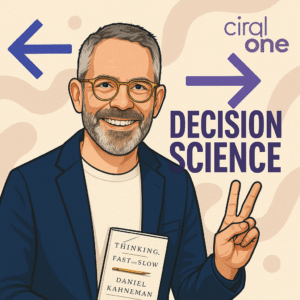Did I Make the Right Decision – Or Was It Just Luck?
How Smart Decision are made and how we judge them
Looking back, everything feels so obvious. The player that should have been substituted half-time, the meal choice, the sales person I hired, the discount I gave or the prospect I didn’t call. But was it really?
We often overestimate how clear things were at the time, the information we had back then and the uncertainty we faced. Cognitive biases. It seems the world around us is anyhow focussed on success stories and ignoring the countless failures that never made the headlines.
Michael Jordan once put it perfectly:
“I’ve missed more than 9,000 shots in my career.
I’ve lost almost 300 games.
26 times, I’ve been trusted to take the game-winning shot and missed.
I’ve failed over and over and over again in my life.
And that is why I succeed.”
Failure is part of every journey — but often, it’s invisible.
I recently did some math on my own decision-making:
- Around 1,000 micro-decisions daily × 365 days × 48 years = 18,520,000 decisions
- About 50 routine decisions daily = another 876,000
- Roughly 15 significant decisions daily = 262,800
- Plus 5 major decisions weekly over 22 years in management = 5,720
In total, I’ve likely made around 19 million decisions in my life. Some of them were really good. Some were lucky. And some – I only realized much later – were bad.
So how do we truly learn from past decisions?
In the late 20th century, the discipline of decision science emerged at the intersection of psychology, economics and mathematics. One prominent key figures shaping this field is Nobel Prize winner Daniel Kahneman, whose book Thinking, Fast and Slow was helping me understand decision-making and how I rely on two systems: one fast and intuitive, the other slow and deliberate – and that each has strengths and predictable flaws. Probably the most important take away for me as a gut feeling addict was that I can keep the speed of my instincts and slow down where appropriate with the right structure and frameworks. Of course, at the center: good data.
After more than 25 years in the SAP and data space no surprise you might think. As a matter of fact although these two simple words make all the difference —data that is reliable, relevant and trustworthy. In the age of AI and especially in the context of Agentic AI good data is the basis for good decision making. Even more so once humans are out of the loop.
Building a Single Source of Truth is a motto for the last 20 years, but let’s face it – we all sat through meetings where two people bring 3 different figures. Bringing quality into your decision-making means actively and continuously investing into a unified data foundation that eliminates contradictions and builds transparency.
Modern Lakehouse platforms like Microsoft Fabric, Databricks and Snowflake provide the technological backbone for this. However, they require the right processes and commitment. Otherwise, they’re just as effective as someone handing you Roger Federer’s racket or Rory McIlroy’s golf clubs.
Whether your last decision was brilliant or just lucky, the right data, tools and methodologies will help make your next decisions sharper, more informed and more likely to succeed.
This is just the beginning.
In the next 2 parts of this series, I’ll explore how we can better understand past decisions – and how to set ourselves up for consistently better ones in the future.
Stay tuned.


